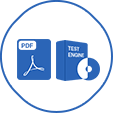Last Update 20 hours ago Total Questions : 75
The Excellence in Design for Greater Efficiencies (EDGE Expert) Exam content is now fully updated, with all current exam questions added 20 hours ago. Deciding to include EDGE-Expert practice exam questions in your study plan goes far beyond basic test preparation.
You'll find that our EDGE-Expert exam questions frequently feature detailed scenarios and practical problem-solving exercises that directly mirror industry challenges. Engaging with these EDGE-Expert sample sets allows you to effectively manage your time and pace yourself, giving you the ability to finish any Excellence in Design for Greater Efficiencies (EDGE Expert) Exam practice test comfortably within the allotted time.
To claim efficiency measure Insulation for Cold Storage Envelope, which of the following documents is required as evidence at the preliminary certification stage?
Who are licensed to train candidates as EDGE Experts and EDGE Auditors?
A building is located in a hot and dry climate where water availability (rainfall) is low. Which of the following measures will give the lowest water savings?
An EDGE Auditor has received initial documentation from a Client which implies that measures not selected on the downloaded PDF can be claimed. What should the Auditor do?
Which of the following can deliver the highest efficiency in fans and pumps?
When must the registration fee be paid?
For a project in a hot and dry climate with no air-conditioning system, which of the following will NOT have an impact on the occupants' thermal comfort?

